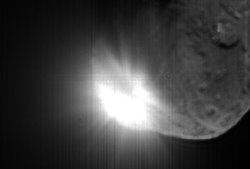"Deep Impact"
 aunched on January 12th, 2005 set a precedent in space exploration. Never before had a spacecraft (or part of a spacecraft) been designed to impact a comet to observe the outcome. Scientists went through rigorous calculations to send Smart Impactor, a 370kg copper slug, 431 million km through space and hit Templar 1, a comet half the size of
aunched on January 12th, 2005 set a precedent in space exploration. Never before had a spacecraft (or part of a spacecraft) been designed to impact a comet to observe the outcome. Scientists went through rigorous calculations to send Smart Impactor, a 370kg copper slug, 431 million km through space and hit Templar 1, a comet half the size of It was a pretty impressive challenge to get a rocket up there and have it point in there and blast. There were a lot of people watching it from earth to see what kind of change happened in the comet. It got quite bright, actually. They were actually taking spectra of what came of the comet. They actually got some new information from it. It was like a giant snow drift
The Impactor before destruction, Flyby aircraft, space telescopes and observatories recorded a myriad of scientific data from the one time event. The data brought startling insight into how the Earth was formed and promoted the theory that many of the necessities to create life were brought to this world by a comet.
 On July 21st, the Flyby spacecraft executed a trajectory change that is expected to have the craft fly past the Earth on December 31st, 2007. At that time NASA will consider capturing the craft and sending it to another comet.
On July 21st, the Flyby spacecraft executed a trajectory change that is expected to have the craft fly past the Earth on December 31st, 2007. At that time NASA will consider capturing the craft and sending it to another comet.
Sources:
http://deepimpact.jpl.nasa.gov/home/index.html
